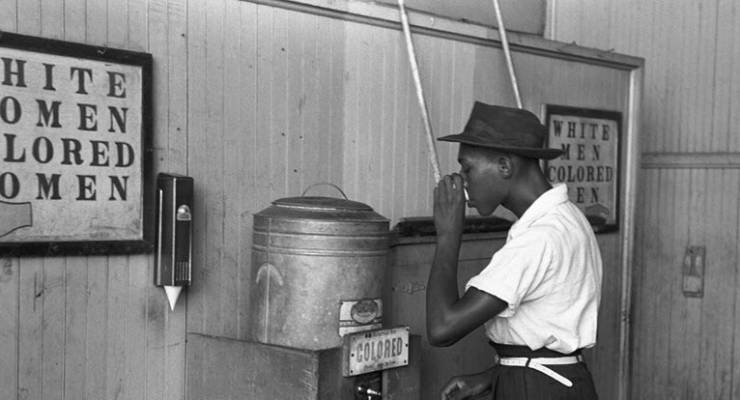
Roger Corbett. These old white males who never die, are constantly promoted and ever willing to defend their privileges in calm, whiskered tones. If this were England, he’d have been made Lord Biggles-Pudding long ago.
There he was on 7.30, exposing with unconscious blitheness the full truth of the reasons why The Gays can’t have marriage. He’d been called up as token Business Leader for the No Case, and appears to have taken his talking points from www.someofmybestfriendsare.com. He deserves full credit for laying bare, finally, what we’re really talking about here. It isn’t Safe Schools.
“Well, first of all, I would like to say that I have many gay friends.” Oh ho, here we go, I thought. Get out the popcorn.
And he was off. Gays “have a perfect right to a union that is exactly equal and should be treated exactly equally in the community”. But not marriage. Marriage is “based on the Judeo-Christian tradition”, which makes sense if you ignore the 75% of Australian weddings which are civil, non-religious affairs, and the weddings of religions that are distinctly not Judeo-Christian.
Then we got the “it’s about the children” piece, because only married people can have kids and you can’t plug an iPhone 4 into an iPhone 7 charger, etc.
So far, Roger was following the approved script and maintaining the calm, self-righteous smile of the Jesus-blessed advocate for exclusion. Then Leigh Sales asked him why it was OK for him to speak out but not Qantas CEO Alan Joyce, and Roger went off-piste.
Corbett, for whatever reason, decided to answer this question with reference to slavery. For businesses to speak against slavery, he argued, “I would think that that was entirely appropriate”. But marriage is different, it’s a “norm” of “being between a man and a woman”.
“People deeply believe that. It’s not discriminatory in any way. It’s a statement that is between men and women.”
The alarm bells were going off now at No HQ, but Roger hadn’t yet seen the trap he was so confidently laying for himself. On he ploughed: “A man and a woman can have a similar relationship, but it’s different. A black man and a white man are equal, but they’re clearly different. A black man will never be a white man and vice versa.”
Oh. My. God. I’m sure Roger and I were in sync at that moment. I said it quite loudly and scared the dog, while somewhere, deep in the recesses of his mind, Roger was registering that he’d just blown the gaff wide open.
The justification for denying equal marriage rights to LGBTI people, you see, is an old, old sociological theory, one you don’t hear expounded these days outside a One Nation rally. Thanks, Roger, now we know.
The theory is “Separate but Equal”. It held sway over Western political and legal thought for a solid century in the post-slavery era, from roughly the 1860s to the 1960s. Both the UK (after abolishing slavery in 1833) and the US (which emancipated the slaves in 1863), having accepted, in principle, that all men are created equal, Western philosophy moved on quickly to contemplate the consequences of theoretical equality between the races in a world that remained intransigently racist.
The doctrine of “separate but equal” was one of the manifestations of this conflicted thinking. It led ultimately to apartheid after a detour through eugenics and the Holocaust, and is certainly still far from eradicated (see: Myanmar, right now). An early product was the legally imposed practical segregation of blacks and whites throughout the Southern States via the Jim Crow laws (substantially replicated in Australia too, but we don’t talk about that here).
On June 7 ,1892, Homer Plessy bought a first-class ticket on the East Louisiana Railway and sat himself in a “whites only” carriage. He was ejected, arrested and convicted of a crime under Louisiana law.
Plessy appealed his case to the US Supreme Court, where he asserted that he “was seven-eighths Caucasian and one-eighth African blood; that the mixture of colored blood was not discernible in him; and that he was entitled to every right, privilege, and immunity secured to citizens of the United States of the white race.”
He lost. The court ruled that the Louisiana law, which mandated railways have separate white and coloured carriages, was not unconstitutional. And Plessy was, by Louisiana law, a coloured man. In doing so, the court had a lot of Roger-like things to say. Bear in mind, this was 1896.
“A statute which implies merely a legal distinction between the white and colored races — a distinction which is founded in the color of the two races, and which must always exist so long as white men are distinguished from the other race by color — has no tendency to destroy the legal equality of the two races.”
And again: “Laws permitting, and even requiring, their separation, in places where they are liable to be brought into contact, do not necessarily imply the inferiority of either race to the other … The most common instance of this is connected with the establishment of separate schools for white and colored children.”
“Laws forbidding the intermarriage of the two races … have been universally recognised” as valid, noted the Court.
So, concluded the Court, “the underlying fallacy” of Plessy’s case lay “in the assumption that the enforced separation of the two races stamps the colored race with a badge of inferiority. If this be so, it is … solely because the colored race chooses to put that construction upon it.”
Plessy v Ferguson remained the law in the US until the 1960s. The Supreme Court’s guiding philosophy, that the races were equal but could legitimately be subjected to open discrimination on racial grounds, is partially reflected 121 years later in Roger’s averment that “a black man and a white man are equal, but they’re clearly different”.
There are only two problems with the separate but equal philosophy: it is abjectly immoral and inhuman; and it’s 100% rolled gold bullshit.
The Supreme Court noted in passing the difficulty of classification in reality: some US states at the time counted anyone with “any visible admixture of black blood” as coloured; others required a “preponderance of blood” and still others that “the predominance of white blood” must be three-quarters if you wanted not to be coloured.
Roger, by his own admission, sees the world in black and white; man and woman; gay and straight. As if we can be neatly classified in binary terms, always acknowledging that we’re totes equal but allowing us different legal rights in accordance with the unique characteristics which universally apply to our classification.
A black man cannot ever be a white man. I wonder what my multi-racial children might be allowed to aspire to be in Roger’s world.
If you are LGBTI today, Roger will deny you marriage: you’re equal, but different. If you were female in 1900, a similar philosophy was used to deny you the vote: you were equal, but different. If you were black — or, rather, by Roger’s determination, not white — 50 years ago, well-to-do white folks would have denied you entry to their carriage.
All with a calm, comforting, empathic smile. He has many gay friends, after all. They’re equal to him. But different.








Put Lord Roger up in Lights. He’s a champion for the disaster a “Yes” will bring..
Look what happened 150 or so years after American slavery ended – one of them took the Presidency! And here in Oz disaster came quicker – only 100 or so years after women got the vote one of them became PM.
What disaster awaits us when LGBTIQ’s marry!
God! Next thing you know we’ll have a gay PM! Worse. A gay female PM. A slippery slope indeed.
I think that further experiments in Aus. with a Woman Prime Minister have been firmly nipped in the bud, Let alone a Gay one.
Remember those reconstituted piles of septic tank sludge, who gave PM Julia such a bad time – Rabbit, Jeeves, Misrabelle, Nausea Corp. and all their acolytes are still out there.
What other woman would want to put herself through that?
I think you’ve just described the Leader of the Opposition in the Senate lol
I thought we already had a gay PM. Well, you can only bang on about gay people for so long without others getting suspicious about your motives.
Nuke the disabled gay whales, say I.
Ummmm… …we already had a gay PM, they just didn’t talk about it much in those days… …shhhh!
Obama didn’t come from a slavery background.
Jomo Kenyatta Snr might disagree., mau-mau
Personally I blame ABC management for giving this amiable old dickhead a platform for promoting his arrant stupidity.
I notice Woolies didn’t have the balls to properly call him out.
Great article Michael, wish we could mainstream you.
1. Why should Woolworths respond to someone who ceased to be an employee more than ten years ago?
2. What does possession of a pair of testicles have to do with courage?
I can’t definitely answer your question No. 2.
However I can attest to the incredable bravery of my sweetiepie when defending mine.
“Corbett’s Black & White World” – it was the ABC that had this fossil in as some sort of “independent, impartial captain of industry”, to skin and pass judgement on Rudd (C Sept; 3 2013? ….. Spoon-fed by “I know nothink” conservative groupie Alberici?) : without disclosing his “Liberal-lifer” roots?
I wasn’t able to stomach the full live interview on 7.30 so thanks for filling in the gaps.
A correction: in 1894 females in South Australia were granted the vote (& eligible to stand for parliament).
“… in 1894 females in South Australia were granted the vote (& eligible to stand for parliament).”
Sort of. Technically. But not really. Not fully enfranchised. Contrary to general belief.
See for the Upper House in the SA Parliament, the Legislative Council, and many Local Councils, to be able to vote or be eligible to stand for office there was, until roughly the 1960s, a property requirement in addition to the usual citizen requirements.
You had to own or rent property of a certain value to be placed on the Electoral role for the Leg. Council..
And in those days the majority of women in SA did not own property.
Couldn’t get bank mortgages for starters in those days, most were ‘housewives’ with no separate income, property or wealth from that of their husband.
Like my mum.
She no longer worked at officially so named ’employment’. Her name did not appear on the house mortgage and so she, along with most of her peers could vote in the House of Assembly elections but not for the Legislative Council [which incidentally had right of veto of all bills coming from the Lower House.
Until sometime in the 1960s [I forget when exactly] when Donny Dunstan, dog bless his little pink hot pants, pulled a swifty with electoral reform and by simply changing the wording of the electoral act made it automatic that people [like mum] who were eligible to vote in the Lower House were also able to vote for the Upper House.
So for the first time in her life, when she was about 50 years old, my mum and lots like her, voted for both houses.
It was a bit of a big deal for her, I remember it well [apart from the actual date].
100% YES.